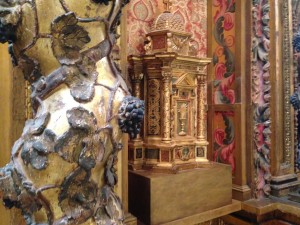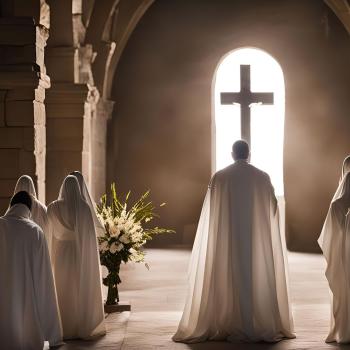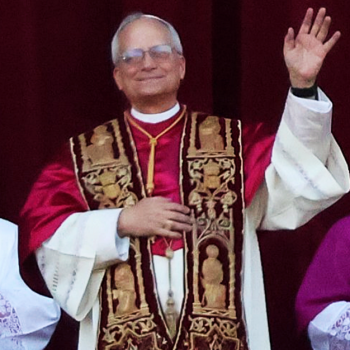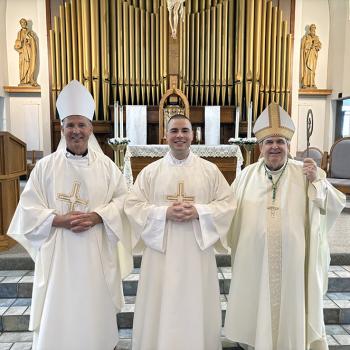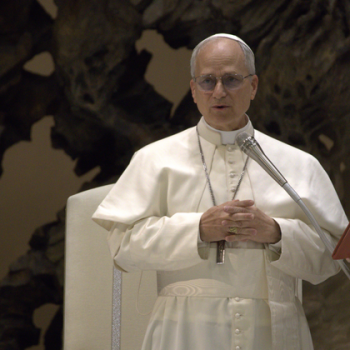For Corpus Christi weekend, a 2012 piece on the history and meaning of the feast. For a beautiful Corpus Christi soundtrack, immerse yourself in Adoration at Ephesus, the latest release from the Benedictines of Mary, Queen of Apostles, which features several settings of material from Thomas’s Office, along with other Eucharistic hymns ancient and not-so-ancient.
This weekend Catholics in the Thursday-averse United States celebrate the Solemnity of the Most Holy Body and Blood of Christ, the feast more familiarly known by its Latin name, Corpus Christi. I can’t get as worked up about the transfer of this feast as I did about Ascension Thursday, mostly because the Feast of Corpus Christi is itself a transfer, and hopped around a lot before settling into the Church’s universal calendar.
We owe this feast—and, by extension, Thomas Aquinas’s stunningly beautiful Office celebrating it—to a 13th-century Belgian nun named Juliana. When Juliana was orphaned at the age of 5, she and her sister were housed on a small farm belonging to a double monastery of Norbertines (the French Augustinian canons known as Premonstratensians—yes, it does indeed sound like PMS—whose order is abbreviated O. Praem; I used to call them the Order of Perambulators).
Juliana, who had a lifelong devotion to the Blessed Sacrament, entered religious life at the age of 13, serving in the hospice for lepers that the community ran. From the age of 16 on she had a series of visions of the full moon obscured by a dark spot. At first troubled that her visions were of demonic origin, Juliana came to discern that instead the moon represented the Church’s liturgical year, and the dark spot a missing feast in honor of Christ present in the Sacrament. While Holy Thursday commemorates the institution of the Eucharist, the joyful mystery of the transubstantiation was, Juliana believed, overshadowed by the solemn events of Holy Week. Juliana thought her visions were telling her to promote such a feast, to be celebrated on the Thursday after Trinity Sunday.
Of course, she had no real means by which to do the promoting (there being no blogosphere or Twitter), so at first Juliana shared her ideas only with a few sympathetic sisters and a holy anchoress named Eve who lived nearby. Eventually, after having been named prioress of the monastery, she told her confessor, who told his superior, who told a bishop, who told a cardinal, and so on up the line to the Holy Father. Everybody agreed it would be no problem to celebrate such a feast, at least on the local level. So Juliana and her confessor composed the first Office for the feast.
But it wasn’t smooth sailing for Juliana. She lived in a time of political and religious turmoil. The same Guelph-and-Ghibelline squabbles that were giving Dante fits also reached Juliana’s convent. She had instituted reforms to bring the monastery back to its strict Augustinian rule, but the male cleric appointed to oversee her—a corrupt politician who had obtained his position by bribery—made her life so miserable with constant harassment and trumped-up charges of financial mismanagement that Juliana twice fled her convent. The first time she found shelter in her friend Eve’s anchorhold. Later, she moved farther afield, living for a time with the Beguines (laywomen who practiced communal lives of prayer and service, later suppressed by the Church for taking heretical positions and not demonstrating obedience to authority), and finally finding a new home among the Cistercians, with whom she lived until her death.
It was the anchoress Eve who continued to push for a universal celebration of the Feast of Corpus Christi, and Pope Urban IV finally relented, commissioning his friend Thomas Aquinas to write the Office we know so well.
Tantum ergo Sacramentum
Veneremur cernui:
Et antiquum documentum
Novo cedat ritui:
Praestet fides supplementum
Sensuum defectui.
Approved first only for clergy, the Feast of Corpus Christi was later extended to the universal Church. Juliana was canonized in 1869, largely on the basis of the virtues recounted in the biography composed by her friend, the anchoress Eve. With all Juliana’s and her feast’s perambulations, it’s only fitting that the Eucharistic processions that once marked the celebration of Corpus Christi are coming back into fashion.
There’s much worth reflecting on in the story of Juliana at this moment in the Church, when Guelphs and Ghibellines are again fighting the battles of Church v State, and Catholics on many fronts are in tension about where the line can be drawn between charism and heresy. It is Juliana’s vision of the moon, though, that carries the message about what was most important then and is most important now: the presence of Christ in the Eucharist that binds us together, without which there is a dark spot, a shadow, on our unity.
Restoring the Eucharist to its central position in our lives is quite simply the only hope we have of getting through this particular dark night. I like to think that Juliana, like Francis, saw the Body of Christ—Corpus Christi—in the twisted and disfigured bodies of the lepers she served, letting faith supply where the senses fall short. If we can look beyond the accidents that divide and distort us and see the Most Holy Body and Blood of Christ present in the Church and in one another, with God’s grace our light will shine brighter than any super moon.
Image: Spanish Colonial retablo in the Cathedral of Our Lady of the Angels, Los Angeles; photo by the author.

